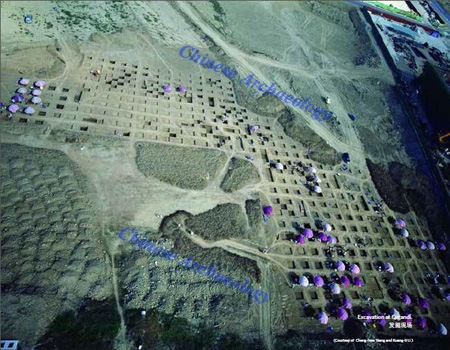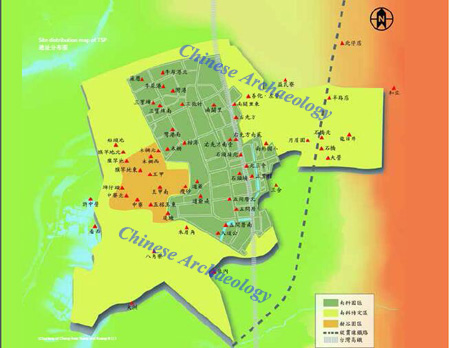Five Thousand Years of Taiwan’s Past Brought to Light by Rescue Archaeology
From:Chinese Archaeology NetWriter:Cheng-hwa TsangDate:2015-12-22
The history of human settlement on Taiwan is of great complexity. A few Chinese traders, fishermen and travelers may have already come to Taiwan at a much earlier date of seventeenth century. In 1624, the Dutch occupied the southwestern coastal region. Two years later, the Spanish arrived and occupied the northern coast, but were soon defeated by the Dutch from the south. In 1662, Zheng Chenggong (Koxinga) and his troops attacked the island from Penghu, drove out the Dutch and began the period of Chinese rule of Taiwan. The Zheng family ruled for only 21 years, from 1662 to 1683, followed by Qing court rule until 1895. As a result, Chinese settlements spread very rapidly from the southwest to other parts of Taiwan, appearing all over the island except for the central mountain range by the mid-nineteenth century. Taiwan was ceded to Japan by the Qing court after the Sino-Japanese War of 1894. Taiwan was once again returned to the Chinese in 1945 when the Japanese were defeated in World War II.Before these multi groups entered Taiwan, however, the island had long been inhabited by peoples speaking Austronesian (Malayo-Polynesian) languages. Since the historic period of Taiwan spans no more than four hundred years, an investigation of the island's human history before the seventeenth century must solely rely upon archaeological studies. Therefore, preservation of archaeological heritage is extremely important to Taiwan.

Excavation at Qigandi.
In recent years, however, due to advances in construction technology and the speed of land development, a large number of archaeological sites are sustaining damage like never before. Because of this, at present, finding ways to protect these precious cultural assets has become another important mission for Taiwanese archaeologists in addition to academic research. The rescue archaeology project in TSP presented below provides a good example.
In order to promote the development of high-tech industries and to provide an impetus for an increase in industry in southern Taiwan, in 1995, the government decided to select an area of 1,043 hectares between today’s districts of Anding, Shanhua and Xinshi of Tainan City in southern Taiwan to serve as the base for the Tainan Science Park (TSP, or Nanke in Chinese). This decision apparently caused great threat to the archaeological heritage at the TSP. In the process of development and construction in the TSP, many archaeological sites would sustain damage from construction projects if no protection and rescue was done. Therefore, archaeologists raced against the construction projects and get to sites before they were obliterated by the backhoes.
The archaeology team of the Institute of History and Philology, Academia Sinica in Taipei was asked to shoulder the major responsibility of monitoring and rescuing archaeological sites at TSP. With the rapid development and construction there, increasing numbers of archaeological sites were discovered in succession.
They had to rush before engineering projects could destroy the sites: working through windy days and through scorching heat, and with dust flying about all around, all in order to save long-buriedarchaeological heritage.
In the last 15 years between 1995 and 2010, five major stages of survey and excavation were carried out on a land over 3,000 hectares in the TSP as well as on neighboring lands that were developed following it. A total of 58 archaeological sites were found and 34 of them were excavated in a large-scale. The total excavated area is over 120,000 square meters.
The TSP rescue archaeology work, with its long history, great use of manpower, and its wide area of excavations, is unprecedented in the history of archaeology in Taiwan. Because of this, the amount of unearthed archaeological remains is considerably huge. Millions of remains have been uncovered, with categories including pottery, stone tools, jades, bone and antler objects, iron objects, bronze, glassware, and other artifacts, as well as plant seeds, animal bones, and other ecofacts. Features include architectural features, ditches, trash pits, and others, and there were over 2,000 burials among these. At present, looking at each site’s unearthed remains and features, we can identify ten archaeological culture phases with dates covering ca. 5000 to 300 BP. The great diversity of these archaeological materials and their variation through time and space not only offer concrete data for the history of human development in the Tainan region, but they also offer much crucial evidence for cultural development history for all of prehistory in Taiwan and including Southeast Asia and the Pacific regions.
In light of the importance of the unearthed archaeological data from the TSP, the National Science Council (now the Ministry of Science and Technology), beginning from December 1, 2006, has subsidized the funding to carry out processing, cataloging and analyzing work on the enormous amount of archaeological materials unearthed. This work plans to be carried out in a period of ten years and brings the rescue archaeology in TSP into a postexcavation stage.
In addition to the laborious processing and cataloging work, this post-excavation stage enables archaeologists to study and interpret archaeological materials collected in the field. A multidisciplinary scientific collaboration, including botany, chemistry, geology, genetics, paleontology, palynology, petrology, physical anthropology and zoology have been launched in order to reveal as much of evidence as possible from the archaeological records and to reconstruct the lifeways of the southern Taiwanese people in the past 5000 years and their changes through time.
The research analyses, which have been carried out, include the C14 age determinations, the reconstruction of ancient geological and geographical environments, the analysis of residence forms and settlement patterns, the study of pottery making technology, the sourcing study of stone tools, the analysis of diet of ancient people, the analyses of health indicators and DNA in the excavated skeletons, morphology and genetic studies of the unearthed rice and millet grains, the analysis of rites and rituals in the archaeological contexts, and so on.

Site distribution map of TSP
Besides the analytical results of the above mentioned researches, one of the most important achievements of the TSP rescue archaeology is the discoveries and excavations of two Dabenkeng culture sites of the early Neolithic period – Nanguanli and Nanguanli East. The studies of the rich archaeological materials from the two sites not only enrich our understanding of the lifeways of the early Neolithic settlers in Taiwan, including their cultivation of rice and millet as well as domestication of dogs, but also provide crucial evidence that can help reconsider the issue of ancient Austronesian dispersal from Asian mainland to the islands of the Pacific Ocean.
The TSP rescue archaeology shows also special significance in the aspect of public archaeology. In the course of the rescue archeology, the relationship between the archaeologists and the developers changed gradually from the conflict at the beginning to coordination and cooperation at the end, so that modern technology and ancient civilization produced a good intersection that made the connotation of TSP more exciting. In addition, along with the archaeological rescue work, a series of public archaeological activities for the students and local residents have been carried out, that have successfully raised the public awareness of preservation of cultural assets, and strengthened the community identity.
In order to properly care for the unearthed cultural relics and to further promote their educational effects, the government has approved the construction of a museum in TSP, which is expected to be completed and open to the public in 2016. That will undoubtedly give to the TSP rescue archaeology a perfect ending.
Cheng-hwa Tsang and Kuang-ti Li
The principal investigator, Dr. Cheng-hwa Tsang, is an Academician of Academia Sinica in Taiwan and a Distinguished Research Fellow at the Institute of History and Philology. His research interests focus on the prehistory of Taiwan and Southeast Asia, and the management of cultural resources and heritage. He is one of the most senior archaeologists in Taiwan. In the past 40 years, he has directed more than 10 largescale archaeological projects and published 11 monographs, edited 12 monographs, and written over 100 journal articles, 31 conference papers, 35 project research reports, and 50 popular science essays, contributing significantly to the reconstruction of Taiwan’s prehistory. The co-investigator, Dr. Kuangti Li, is a research fellow in archaeology at the Institute of History and Philology, Academia Sinica in Taiwan. He has completed more than 30 years of archaeological field research in Taiwan. Li’s research interests mainly focus on prehistoric settlement and subsistence patterns in Taiwan and surrounding areas by using techniques such as isotopic analysis and geometric morphometrics, as well as ancient DNA studies. He is also interested in environmental archaeology, zooarchaeology and subjects on the relationship between diet and strategies of ancient food resource procurement.
(Cheng-hwa Tsang and Kuang-ti Li Institute of History and Philology, Academia Sinica)
(Source: Research Center for World Archaeology, Shanghai Academy)

